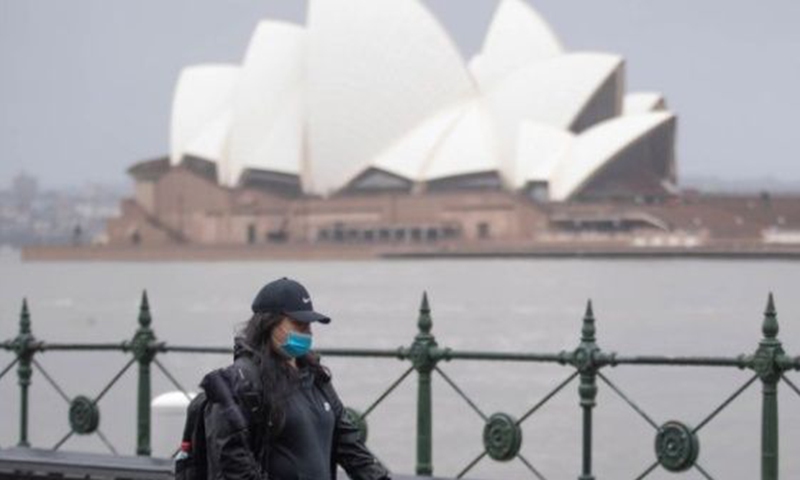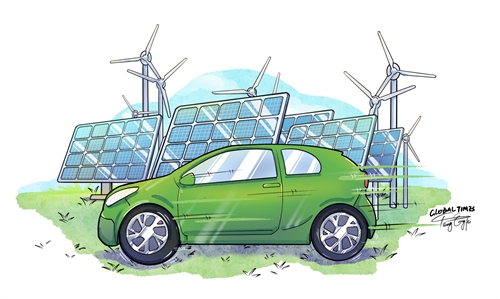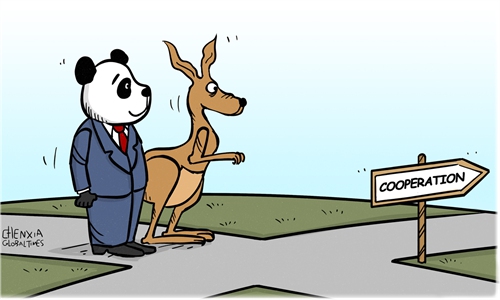
A woman walks past Sydney Opera House in Sydney, Australia, on July, 6, 2022. Photo: Xinhua
External observers are often puzzled by Australia's rather erratic behavior in terms of international relations. One moment, China is a "good friend"; another moment, China is an "enemy." In the past, Japan was the enemy - a real enemy - but now it is supposedly a "good friend." Even more, Australia's location is in southeast Asia, and yet it is seen by many as a "Western" country. English is the most common language, and yet more than 300 languages are spoken in Australia. The second-most spoken language in Australia is Putonghua (Mandarin). As for me, I was born in Australia but I spoke Dutch when I first learned to speak. Contradictions, contradictions … The list could go on.
Why are there so many contradictions? Let me put it this way: Australia has a split identity, and this split has two levels. Let me explain.
The Indigenous question
The most basic split identity in Australia is between First Nations - or Aboriginal and Torres Strait Islanders - and immigrants of the last two centuries. The difference has many aspects. In terms of time, the First Nations have a continuous presence of more than 60,000 years, while British colonization began a little over 230 years ago. The effect of colonization on the First Nations was devastating. There is no point in using polite words here: this was the first time Australia had been invaded, and the First Nations experienced genocide, and thus a crime against humanity, by one of the most brutal and cruel empires in human history - the British Empire. The attempted extermination was aided by a legal fiction known as terra nullius, or empty land, which meant that the existing First Nations could be cleared from the land and no treaties needed to be made.
Thus far, this founding trauma has never been properly recognized and addressed - constitutionally, economically, socially, and culturally. Unless it is fully addressed, it will remain an unresolved contradiction at the heart of the modern state of Australia. How? On the one hand, Australia presents itself internationally as a modern, European-style state. On the other hand, the land of the First Nations was never ceded and sovereignty was never extinguished; the land has always been and will always be Aboriginal land. Clearly, this produces a split identity, which can be resolved only when the underlying contradiction is addressed.
Role of the ruling elite
The second level of the split identity concerns the way the ruling elite tries to present Australia and the demographic realities of the common people. To understand this split, I address each side in turn.
As a very wise man once said, "the ruling ideas of an age are the ideas of its ruling class." Even today, the ruling elite in Australia remains overwhelmingly white and English-speaking. True, there are some exceptions, and their number has been increasing, but the ruling elite remains firmly English-speaking and Western.
How do these leaders try to influence the culture of Australia? For the ruling elite, the points of reference are the former colonial masters (the British) and the new colonial masters (the USA). The rest of the world counts only as a point of difference. For example, there is an appalling lack of knowledge about and concern with Australia's nearest neighbor: Indonesia. And as we know, the way China is represented is often distorted.
In terms of education, the program has long been a Western liberal one. This has been my experience at school and university. In fact, in my time the teaching of "history" went through English history, the colonization of Australia, and then Australian history from that point onwards. True, these days there is more about the history of First Nations, but the weight remains heavily on the post-1788 history. It should be no surprise that history is the most contested territory in determining the educational curriculum.
A ruling elite, however, is not uniform. An important distinction can be made between political and business leaders. The two may overlap in many ways, but when it comes to foreign policy, sharp differences emerge. The political leaders are usually driven by ideological concerns and will readily construct an imaginary enemy so as to gain political advantage at home. By contrast, business leaders are interested not in ideology but in business. Given that China has long been Australia's primary trading partner, many of these business leaders have been resolutely opposed to the recent bout of "China-bashing" undertaken by the former government in Canberra. Notably, the expat Australian business communities in Shanghai and Guangzhou, who have spent decades developing business opportunities, have been very critical of the political leaders in the last few years.
Changing demographics
The ruling elite comprises only one aspect. The other concerns the common people and the demographics of Australia.
One of the best ways to gain an insight into Australia's changing demographics is by considering the languages that are spoken. More than 300 languages are spoken in Australia (including about 130 Indigenous languages). English is the most commonly spoken language. More tellingly, the percentage of the total population - 25 million and growing - that speaks English as the first language has been declining steadily. For example, twenty years ago about 80 percent of the population spoke English as the first language at home. Now it has dropped to less than 72 percent. This means that more than a quarter of the population speaks another first language at home.
So what other languages do people speak? By far the highest is Putonghua, which has grown rapidly in the last decade or more to reach almost three percent of the population. In the top ten we also find Arabic, Vietnamese, Punjabi, Cantonese, Filipino and Hindi. Yes, almost all of these are Asian languages, with Arabic also drawing parts of northern Africa into the group.
Language is a window into culture. This means that Australia's cultural identity as "Western" - derived from the colonial era, is quite uncertain. In other words, when the predominantly white and Western ruling elite speaks as though Australia is part of the "West," these assertions do not resonate with more than one quarter of the population. And if we find the political leaders trying to assert Australia's position in the "Anglosphere," then the number drops much further. For someone like myself, of Dutch background, I simply do not identify with the "Anglosphere."
This level of the split identity should now be clear: on the one hand, the ruling elite tries to hang onto the label of "Western," on the other hand, more and more the population are of a non-Western background, and increasingly of an Asian background.
What is Australia?
We are left with the question: what is Australian identity? Is it First Nations or colonizer-immigrant? Is it "Western" or southeast Asian? Is it part of the "Anglosphere" or it part of the vast majority of a very diverse world? More philosophically, we can say that the answer is not either one or the other, but should be both one and the other. Of course, the recognition of this reality would require a significant cultural shift.
I began by pointing out that observers are often perplexed by Australia's rather erratic approach to international relations. By now it should be clear that if a country is not certain about its identity - or rather, if it cannot face and recognize its internal contradictions - it is difficult to expect a coherent, stable and independent foreign policy.
The author is a Marxist scholar from Australia, distinguished overseas professor at Renmin University of China, and on editorial board of the Australian Marxist Review. opinion@globaltimes.com.cn



